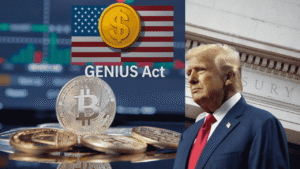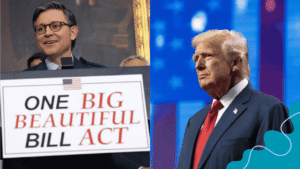Washington: President Donald Trump signed an executive order on August 7, 2025 directing federal agencies to make it easier for 401(k) and other defined contribution plans to offer alternative assets such as private equity, real estate and cryptocurrencies, according to the White House fact sheet on the order. The order asks the Labor Department, the Securities and Exchange Commission and the Treasury to revisit guidance and rules that have discouraged these investments in workplace retirement accounts, as reported by Reuters.
Key Takeaways for Savers
- Trump’s order opens the door for 401(k) plans to invest in private equity, hedge funds, and even cryptocurrencies — a major shift from traditional stock and bond portfolios.
- While supporters see this as a chance for higher long-term returns and better diversification, critics warn that the risks, fees, and complexity could outweigh the benefits for many savers.
- Implementation will depend on new Labor Department guidance, which could take six months to a year before plans can officially adopt these options.
- Plan sponsors are expected to face greater fiduciary responsibility, making careful vetting and participant education essential before offering such investments.
- Savers should prepare to ask more questions about fees, lock-in periods, and risk exposure before considering these new 401(k) options.
The White House said the change is meant to expand investment choices for about 90 million American participants in employer plans, and to give ordinary workers access to asset classes historically reserved for big pensions and wealthy investors.
“This is about giving American workers the same opportunities as the biggest funds,” Trump said at the signing ceremony, per USA Today.
The order does not instantly put private equity or crypto into your plan. Agencies must rewrite regulations and issue guidance, and plan sponsors will still face fiduciary duties under Employee Retirement Income Security Act of 1974 (ERISA), as emphasized in a U.S. Department of Labor statement. That means any practical rollout could take months or longer, and many employers will move cautiously while regulators and courts sort out the new rules.
Table of Contents
Why this order matters for 401(k) savers
It opens a large pool of savings to new players.
Defined contribution plans hold roughly $12 trillion in U.S. retirement savings, according to data from the Investment Company Institute. Allowing alternatives would give private equity and crypto managers access to a huge new source of capital and could reshape how many retirement portfolios are constructed. For asset managers this is a major market opportunity. For savers it is a potential change in the risk profile of typical workplace plans.
“If you open the gates, you are changing the very DNA of 401(k) investing,” said Alicia Munnell, director of the Center for Retirement Research at Boston College, as cited by Reuters
Potential benefits: more options, possible higher long term returns.
Supporters argue that private markets and some real assets have historically delivered higher returns than broad public markets over long periods, according to a Morningstar analysis. And that giving ordinary investors a route into these assets can improve diversification and total returns when done properly.
Advocates also say younger savers with long time horizons could benefit from a mix that leans into illiquid growth assets early and becomes more conservative as retirement nears.
Real risks — fees, liquidity, transparency and legal exposure.
Private equity and many alternatives carry higher fees than the mutual funds that dominate 401(k) menus, as outlined by the SEC’s Office of Investor Education. Private funds often use fee structures such as the so called two and twenty model, while mutual funds in plans average only a few tenths of a percent in fees. Illiquid assets do not trade daily, so pricing is less transparent and the value of holdings can be hard to state precisely.
Those features create practical problems for participant reporting and for plan sponsors who must meet ERISA fiduciary duties. Legal risk is not hypothetical: plaintiffs have sued plans that included complex or hard to value investments, and litigation worries are a central theme in discussions about this change, according to court filings reviewed by Reuters.
What this will look like in practice.
Expect a phased approach. Regulators have been told to clarify the fiduciary rules and to consider how to permit alternatives while protecting participants, as per the executive order. Asset managers are already preparing products that bundle private assets into funds designed for defined contribution plans, and some large firms have publicly signaled plans to offer such funds, according to statements from Blackstone and Apollo. Even so, most experts say wide adoption will be gradual because of operational hurdles, disclosure demands and sponsor caution, as reported by Reuters.
“It is not going to be a floodgate moment,” said Aron Szapiro, head of retirement research at Morningstar, to Investopedia
Short checklist for savers and plan sponsors right now
- Do not assume your plan will change overnight. Regulatory revisions are required first, as stated by the Department of Labor in its Q&A. The White House
- If you are a saver, take this as an early heads up. Talk with your financial advisor before chasing alternative strategies, as per guidance from the Financial Industry Regulatory Authority. Investopedia
- If you are a plan sponsor, document any process that considers alternatives and consult ERISA counsel. Regulators and courts will want to see careful fiduciary procedures. Reuters
Possible Gains for 401(k) Investors from Private Equity and Crypto
Backers of the move say this is about bringing retirement plans in line with the evolution of global capital markets. Public markets have shrunk in terms of listed companies over the last two decades, while private markets have grown rapidly in both size and influence. According to a Reuters analysis, private equity assets under management globally now top $13 trillion, and more companies are staying private for longer, meaning public market investors miss some of the biggest growth stages.
“This is about giving regular workers access to the same opportunities that institutional investors have had for decades,” said President Donald Trump during the signing event. He framed the change as a fairness measure, arguing that long-term savers could see better returns by participating in early-stage or growth-focused private deals.
Financial industry groups have echoed that view. The Investment Company Institute told Investopedia that, when structured properly, alternative investments could improve diversification and help certain savers manage long-term risks, especially in inflationary or low-yield environments. Some plan sponsors also point to examples from large pension funds, where alternatives have been part of portfolios for decades and have in some cases outperformed public equity benchmarks.
Still, even those in favor admit that success depends on design and execution. Funds will need to fit within 401(k) liquidity and valuation rules, and participants must be educated on the risks. As per Alicia Munnell, director of the Center for Retirement Research at Boston College, told Reuters, “If you open the gates, you are changing the very DNA of 401(k) investing.”
Critics Warn of Higher Risk and Less Transparency for Workers
Skeptics see the order as an unnecessary gamble with retirement savings. Private equity funds often charge high management and performance fees, which can erode returns over time. The SEC’s Office of Investor Education has long warned that alternative assets can be illiquid and difficult to value, meaning investors may not know what their holdings are truly worth at any given time.
There is also the question of legal exposure. The U.S. Department of Labor has previously cautioned that plan fiduciaries could face lawsuits if participants suffer losses in complex or illiquid products without proper due diligence and disclosure. In recent years, courts have seen a rising number of ERISA cases challenging the inclusion of nontraditional investments in retirement menus.
Some critics are blunt about the risks. “The promise of higher returns often masks the reality of higher fees and higher volatility,” said Barbara Roper, senior adviser at the Consumer Federation of America, in comments reported by USA Today. She warned that many participants lack the time or financial knowledge to evaluate complex fund structures.
Consumer advocates also highlight that alternative assets are not immune to market downturns. Private equity portfolios suffered sharp valuation markdowns during the early months of the COVID-19 crisis, and crypto markets have shown extreme swings in value. “You are asking workers to take on risks that even professional investors sometimes misjudge,” noted an Investopedia editorial on the policy change.
What Experts Are Saying (and Where to Watch)
Industry voices are already weighing in on the decision, and opinions could not be more divided. Some retirement consultants told Reuters the move could diversify portfolios and help plans keep pace with evolving global markets. Others warn that such diversification, while appealing in theory, introduces layers of risk and cost that many savers are not prepared for.
A report from the Investment Company Institute emphasized that private equity investments often come with long lock-in periods and complex fee structures. These factors can be difficult for the average 401(k) participant to fully understand, raising concerns about transparency and suitability.
Several market analysts are watching how large asset managers respond. If the biggest 401(k) providers adopt private equity or crypto exposure quickly, smaller plans may feel pressure to follow even if they lack the infrastructure to manage the additional due diligence. According to Morningstar, a similar pattern occurred in the early 2000s when target-date funds gained popularity, creating both benefits and unintended consequences for retirement savers.
Author Insight

Dileep K Nair CMA
Senior Editor & Expert Reviewer
In my years reporting on capital markets and alternative investments, I have rarely seen a regulatory shift that could deliver such a double edged impact. On one hand, this move could unlock billions in fresh limited partner (LP) capital for private equity firms. This could potentially reshape their fundraising for many years. A steady flow of 401(k) contributions redirected toward these funds could give the industry a scale and stability it has long sought.
But the equation is not all upside. A surge in LP capital could compress returns if too much money chases a limited number of quality deals- a pattern that I have observed during previous liquidity booms. For retirement savers, the benefits will hinge entirely on execution. Access to high yielding private investments can be rewarding, but only if the cost structure, risk controls and transparency match the promise. Otherwise, this could become yet another well intended reform that benefits fund managers far more than the people whose savings make it possible.
When Changes Could Take Effect and What Plan Sponsors Should Do
While the order has been signed, actual implementation will depend on how quickly the Department of Labor updates its guidance for plan fiduciaries. According to USA Today, the administration has asked for draft guidance within six months, though final rules could take up to a year.
Plan sponsors will need to review their investment policy statements and consult legal counsel before adding these new options. Fiduciary duty will remain a critical factor, any failure to act in the best interest of participants could trigger regulatory or legal action.
Some industry attorneys suggest starting with pilot programs or offering such investments only to participants who actively opt in and meet certain net-worth or investment experience criteria. The American Benefits Council has already urged the Labor Department to provide clear guardrails to protect both workers and employers.
Until the rules are finalized, sponsors are expected to monitor developments closely and prepare for participant education efforts. Clear communication will be key, especially for explaining potential risks, fees and long term return expectations.
Trust and Transparency Disclaimer
This news article is based on information from credible public sources including Reuters, USA Today, and Investopedia, as of the date of publication. Market conditions, policy details, and implementation timelines may change, so readers are encouraged to verify independently before making financial decisions. GlimMarket has no financial stake in any entities mentioned in this article, and editorial coverage is not influenced by commercial relationships. This is not financial advice; consult a qualified advisor for personalized guidance on retirement investments.
Related Articles

US–EU Trade Deal Brings 15% Tariff on Imports: What It Means for Businesses, Consumers, and Investors

Historic US–EU Trade Deal Slaps 15% Tariff on EU Imports: Who Wins and Who Loses?

India, UK Sign Landmark Free Trade Agreement: 99% Tariff Free Access, Visa Boost, $34 Billion Trade Surge Expected

Fed Governor Waller Pushes for July Rate Cut Amid Internal FOMC Split

Trump Signs GENIUS Act Into Law, Setting First Federal Stablecoin Rules

Trump Signs One Big Beautiful Bill into Law: Here’s Why It Matters You
Budget. Forecast. Analyze. Repeat.
Get expert-level financial insights that help you steer your business confidently.
What to Read Next
Explore expert guides on funding, growth, history, and step-by-step strategies for success.
- How to Get a Startup Business Loan with No Money in 2025
- Preparing Your Company for Private Equity: A Checklist for Success
- How to Start a Small Business: A Step-by-Step Guide
- Business Checking Account 2025: A Useful Guide
- The History of Private Equity: How It Shaped Modern Business and Investment Trends
You Might Also Like
In our commitment to ensuring accuracy and credibility, we prioritize the use of primary sources to support our reporting. This includes white papers, government data, original reporting, and interviews with industry experts. We also reference original research and findings from reputable publishers when appropriate. We always ensure that proper attributions and citations are provided with source links, within the article itself, to uphold transparency and fair practice. To learn more about the standards we uphold in producing accurate and unbiased content, please refer to our Editorial Policy & Guidelines.













